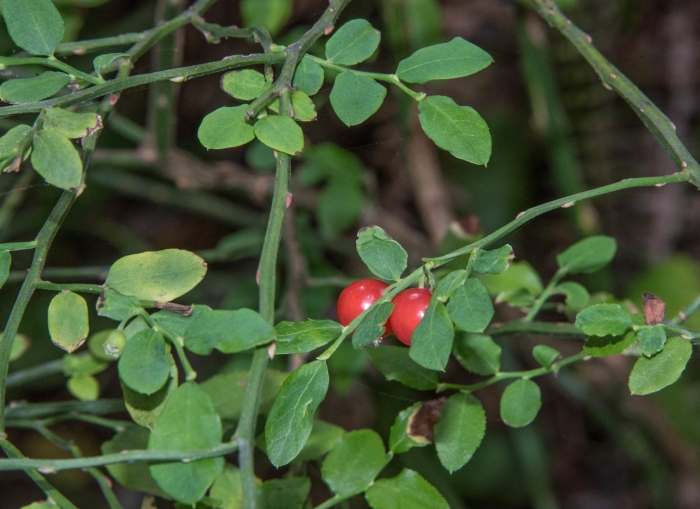Red Huckleberry
(Vaccinium parvifolium)
Red Huckleberry (Vaccinium parvifolium)
/
/

Don Loarie
CC BY 4.0
Image By:
Don Loarie
Recorded By:
Copyright:
CC BY 4.0
Copyright Notice:
Photo by: Don Loarie | License Type: CC BY 4.0 | License URL: http://creativecommons.org/licenses/by/4.0/ | Rights Holder: Don Loarie | Publisher: iNaturalist | Date Created: 2017-06-26T10:24:03-07:00 |



















































Estimated Native Range
Summary
Vaccinium parvifolium, commonly known as Red Huckleberry, is a deciduous shrub native to the understory of coniferous and mixed forests in western North America, from southeastern Alaska and British Columbia through western Washington and Oregon to central California. It typically grows to a height of 4 meters (13 feet) with bright green, angular shoots. The shrub is notable for its small, bell-shaped flowers that are yellow-white to pinkish-white with a hint of pink, appearing in the spring. The flowers are followed by edible red to orange berries, 6 to 10 millimeters in diameter, which are a food source for local wildlife and can be used in jams and pies.
Red Huckleberry is appreciated for its ease of maintenance and the ornamental quality of its berries. It is used in natural landscaping, native plant gardens, wildlife gardens, and restoration projects. The plant thrives in acidic soil with a pH of 4.5 to 6 and requires minimal water once established, making it suitable for low-maintenance gardens. It prefers full sun to part shade and well-drained soil. While it does not tolerate root disturbance, it can be propagated by softwood cuttings or seeds. Gardeners should note that it may be susceptible to fungal diseases if conditions are too wet.CC BY-SA 4.0
Red Huckleberry is appreciated for its ease of maintenance and the ornamental quality of its berries. It is used in natural landscaping, native plant gardens, wildlife gardens, and restoration projects. The plant thrives in acidic soil with a pH of 4.5 to 6 and requires minimal water once established, making it suitable for low-maintenance gardens. It prefers full sun to part shade and well-drained soil. While it does not tolerate root disturbance, it can be propagated by softwood cuttings or seeds. Gardeners should note that it may be susceptible to fungal diseases if conditions are too wet.CC BY-SA 4.0
Plant Description
- Plant Type: Shrub
- Height: 4-10 feet
- Width: 2-5 feet
- Growth Rate: Slow
- Flower Color: White, Pink
- Flowering Season: Spring
- Leaf Retention: Deciduous
Growth Requirements
- Sun: Full Sun, Part Shade
- Water: Medium, High
- Drainage: Fast, Medium
Common Uses
Bee Garden, Bird Garden, Butterfly Garden, Edible*Disclaimer: Easyscape's listed plant edibility is for informational use. Always verify the safety and proper identification of any plant before consumption., Erosion Control, Fire Resistant, Hummingbird Garden, Low Maintenance
Natural Habitat
Understory of coniferous and mixed forests in western North America
Other Names
Common Names: Red-Huckleberry, Red Bilberry, Airelle Rouge, Airelle À Petites Feuilles
Scientific Names: , Vaccinium parvifolium,
GBIF Accepted Name: Vaccinium parvifolium Sm.